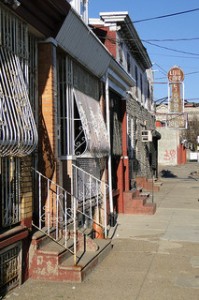Curbing violence in America’s inner cities has long been a difficult challenge. A wide variety of tactics have been tried – ranging from enforcement focused on gangs or repeat offenders to new preventive initiatives by social service providers. Affected neighborhoods have also been targeted for such measures as an increased police presence, the organization of neighborhood watch networks, and efforts to remove or clean up visible signs of disorder, such as abandoned cars, blighted buildings, junk-filled vacant lots, graffiti, and the presence of loiterers or beggars.
Until recently, objective evidence about effectiveness of various police tactics was so mixed that many scholars concluded that actions by authorities make little difference. But a 2010 study by the Campbell Collaborative at George Mason University analyzed more than forty crime prevention programs of all types to see what works best. According to study results, efforts focused on either arresting or giving more social services to individual offenders proved to be less effective than programs that concentrated on reducing the opportunity for crime to occur in small geographic areas known as “hot spots.” Some refer to this approach as “hot spots policing” and others call it “problem-oriented policing,” as I do here.
How Problem-Oriented Policing Works
Problem-oriented policing builds on the well-known fact that crime is not random; rather, it is concentrated in relatively few neighborhoods and small areas within them. Studies of many cities have found that about ten percent of addresses, street corners, and street segments account for about 80% of the crimes and calls for service to the police. These locations offer many opportunities for motivated offenders to make contact with potential victims – because of features such poor lighting, blind alleys, abandoned buildings, gathering spots for unsupervised youth, and concentrations of illicit businesses. Problem-oriented policing seeks to alter such features in order to reduce opportunities for contacts between victim and offenders.

A key to success is ongoing collaboration between police leaders and neighborhood residents and business owners. Police proceed, step by step, using a well-understood script:
- Identify hot spots. Where and when are crimes of interest clustered geographically?
- Look closely. Collect information on the neighborhood and calls that come to the police, and consult residents to tap their knowledge of local needs and crimes in the area.
- Identify patterns. Analyze all information about patterns of criminal behavior and victimhood.
- Respond. Involve community leaders and neighbors in designing and implementing new strategies to solve the problems revealed by the analysis.
- Assess. Regularly re-analyze the data on crime to see what is working and fine-tune efforts.
What do the police and community leaders actually do? Problem solving can include repairing street lights and modifying traffic and pedestrian patterns, and cleaning lots and boarding up abandoned buildings to make them less accessible to criminals. Equally important, police patrols are re-designed so that a random, visible presence appears at known crime hot spots. All of this has been shown to get results. Research in U.S. cities has consistently shown that a 4%-10% reduction in crime and calls to the police can result. The surrounding areas experience a reduction of crime, too; and the benefits do not end even when intense police efforts are scaled back.
An Encouraging Example from New Orleans
A recent police effort focused on a four-square block area in the French Quarter of New Orleans, Louisiana. After learning that about 63% of violent crimes and 61% of police calls for service were clustered in this hot spot, the police took the following actions:
- Specially designed random patrols that ensured a uniformed officer would be recurrently present in the area for up to ten minutes at a time between 8:00 PM and 4:00 AM.
- Stepped-up efforts to control behavior in and around night clubs, bars, and restaurants. Licenses were inspected and waitresses who sold shots of liquor on the street were stopped.
- Redesigned the flows of patrons into and out of two popular nightspots, and trained their bouncers to assist patrons who – while dancing, going outside, or going to the restroom – had been routinely leaving unattended easily stolen items like cell phones.
- Repaired hazardous walkways, secured gates leading to unattended alleys or interior courtyards, and fixed some burnt-out lights and accessed privately owned surveillance cameras.
- Helped design a privately funded camera initiative by the neighborhood association.
Such straightforward steps took about three weeks to implement, yet got results. Tracked over the next six months, aggravated assaults and batteries dropped by 6%; thefts inside bars declined by 9%; and calls for police help went down by 11%. There was no effect on robberies.
A Formula for Effective Police Work
Research demonstrates that police resources should not be scattered, because crime is not random. Of course, police departments should not abandon longstanding enforcement techniques. But the basic logic behind problem-oriented policing can inform all kinds of efforts to fight crime and reduce disorder. As police are trained and learn to use data collection and analysis and cooperate with residents to address environmental problems, their accomplishments will build public support. Multiple hot spots can be addressed simultaneously, and some will improve quickly. As one hot spot cools, police can shift to address other places experiencing problems. A combination of focused efforts and routine responsiveness to the community will make police efforts purposeful and visibly effective. Most citizens will applaud and cooperate.—–
Read more in George E. Capowich, “A Quasi-Experimental Evaluation of Problem-Oriented Policing as a Violence-Reduction Strategy.” (forthcoming).

 Research to Improve Policy: The Scholars Strategy Network seeks to improve public policy and strengthen democracy by organizing scholars working in America's colleges and universities. SSN's founding director is Theda Skocpol, Victor S. Thomas Professor of Government and Sociology at Harvard University.
Research to Improve Policy: The Scholars Strategy Network seeks to improve public policy and strengthen democracy by organizing scholars working in America's colleges and universities. SSN's founding director is Theda Skocpol, Victor S. Thomas Professor of Government and Sociology at Harvard University.